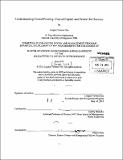| dc.contributor.advisor | Andrey Malenko. | en_US |
| dc.contributor.author | Teo, Lingkai Terence | en_US |
| dc.contributor.other | Massachusetts Institute of Technology. Engineering Systems Division. | en_US |
| dc.date.accessioned | 2014-01-09T19:57:05Z | |
| dc.date.available | 2014-01-09T19:57:05Z | |
| dc.date.issued | 2013 | en_US |
| dc.identifier.uri | http://hdl.handle.net/1721.1/83806 | |
| dc.description | Thesis (S.M. in Engineering and Management)--Massachusetts Institute of Technology, Engineering Systems Division, 2013. | en_US |
| dc.description | Cataloged from PDF version of thesis. | en_US |
| dc.description | Includes bibliographical references (pages 63-64). | en_US |
| dc.description.abstract | Since the advent of Web 2.0, crowd funding has played an increasingly important role as a means of financing for startup companies. Crowd funding is a particular means of financing where money is obtained from the public in exchange for equity or rewards. Currently, only accredited investors, including investment firms, pension funds and individuals with personal net worth of at least $1 million or earning at least $200,000 a year (US Securities and Exchange Commission, 2012) can invest in private companies and get equity in return. With the passing of the JOBS Act by President Barack Obama in April 2012, making investments in exchange for equity in private companies will soon be available to small investors. This thesis examines the phenomenon of crowd funding through estimating the cost of capital for the crowd funded projects and the factors influencing their success. Data is obtained from a popular fund raising website, Kickstarter and analysis is carried out using regression. The results show that the probability of a successful fund raising campaign is rather low, at 43%. Setting a low funding target, entering a market that has fewer competing products and building up popular support through captivating design or meeting latent user needs is associated with a higher probability of fund raising success. In addition, though the median cost of capital is negative, the cost of capital exhibits a wide range and it may be more expensive to fund projects through crowd funding compared to debt financing, which has a much smaller spread of its cost of capital. As such, the results show that a lower the cost of capital is associated with a lower cost of goods sold, faster delivery of rewards and a high proportion of free capital, which may be obtained by encouraging donations or asking for a higher price premium for its products relative to retail price. | en_US |
| dc.description.statementofresponsibility | by Lingkai Terence Teo. | en_US |
| dc.format.extent | 64 pages | en_US |
| dc.language.iso | eng | en_US |
| dc.publisher | Massachusetts Institute of Technology | en_US |
| dc.rights | M.I.T. theses are protected by
copyright. They may be viewed from this source for any purpose, but
reproduction or distribution in any format is prohibited without written
permission. See provided URL for inquiries about permission. | en_US |
| dc.rights.uri | http://dspace.mit.edu/handle/1721.1/7582 | en_US |
| dc.subject | Engineering Systems Division. | en_US |
| dc.title | Understanding crowd funding : cost of capital and factors for success | en_US |
| dc.type | Thesis | en_US |
| dc.description.degree | S.M.in Engineering and Management | en_US |
| dc.contributor.department | Massachusetts Institute of Technology. Engineering Systems Division | |
| dc.identifier.oclc | 865475801 | en_US |
